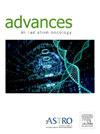Dosimetric Predictors of Acute Radiation Pneumonitis and Esophagitis in Hypofractionated Thoracic Irradiation of Non-Small Cell Lung Cancer Patients With Poor Prognostic Factors
IF 2.7
Q3 ONCOLOGY
引用次数: 0
Abstract
Purpose
The proliferation rates of non-small cell lung cancer (NSCLC) and associated radiation resistance highlight the potential of hypofractionated radiation therapy (hypoRT). However, radiation pneumonitis and esophagitis remain dose-limiting adverse events. This study investigates dosimetric factors influencing the risk of pneumonitis and esophagitis in highly multimorbid patients undergoing moderately hypoRT.
Methods and Materials
Forty-seven NSCLC patients with poor performance status treated between January 2014 and July 2021 were included. Dosimetric parameters including mean lung dose (MLD), percentage of normal (ipsi-/contralateral) lung volume (Vx) receiving ≥x Gy (x = 20, 18, 10, and 5 Gy); mean heart dose (MHD), percentage of the heart volume (HVx) receiving ≥x Gy (x = 20, 10, and 5 Gy); and mean esophageal dose (MED), percentage of esophagus volume (EVx) receiving ≥x Gy (x = 40, 30, 20, 18, 10, and 5 Gy) were analyzed retrospectively. Acute radiation pneumonitis/esophagitis events were assessed within 6/3 months posttreatment. Statistical analyses included random forests, binary logistic regression, and linear regression.
Results
Among the 47 patients with compromised lung function and poor prognostic factors, 8 (17%) and 26 (55%) patients developed all-grade pneumonitis or esophagitis, while 4 (9%) and 10 (21%) patients developed CTCAE grade ≥2 pneumonitis and esophagitis, respectively. Exploratory analyses suggest that V10, V18, and MLD values are associated with an increased risk of pneumonitis. Linear regressions confirmed this for MLD values greater than 9.2 Gy (P = .050). Additionally, higher V5 and V10 values in the contralateral lung were associated with a greater risk of pneumonitis (P = .013/P = .032). Dmax proved to be a significant predictor of esophagitis (P = .020). Moreover, evidence suggests that EV5 and EV40 may portend esophagitis onset.
Conclusions
This study provides insights into dosimetric factors influencing pneumonitis/esophagitis development in NSCLC patients undergoing hypoRT. While MLD and Dmax emerged as significant predictors of pneumonitis and esophagitis, the small sample size limited the depth of conclusions. Further research with larger cohorts is warranted to validate these observations, potentially optimizing treatment planning and outcomes in this challenging patient population.
不良预后因素的非小细胞肺癌低分割胸廓照射急性放射性肺炎和食管炎的剂量学预测因子
目的:非小细胞肺癌(NSCLC)的增殖率和相关的放射耐药突出了低分割放射治疗(hypoRT)的潜力。然而,放射性肺炎和食管炎仍然是剂量限制的不良事件。本研究探讨了剂量学因素对接受中度高肝移植的高度多病患者肺炎和食管炎风险的影响。方法和材料:纳入2014年1月至2021年7月期间接受治疗的47例非小细胞肺癌患者。剂量学参数包括平均肺剂量(MLD),接受≥x Gy (x = 20、18、10和5 Gy)的正常(单侧/对侧)肺体积百分比(Vx);平均心脏剂量(MHD),接受≥x Gy (x = 20、10和5 Gy)的心脏体积百分比(HVx);回顾性分析平均食管剂量(MED)、接受≥x Gy (x = 40、30、20、18、10、5 Gy)的食管体积百分比(EVx)。急性放射性肺炎/食管炎事件在治疗后6/3个月内进行评估。统计分析包括随机森林、二元逻辑回归和线性回归。结果:在47例肺功能受损和预后不良的患者中,8例(17%)和26例(55%)患者发生全级别肺炎或食管炎,4例(9%)和10例(21%)患者发生CTCAE级≥2级肺炎和食管炎。探索性分析表明,V10、V18和MLD值与肺炎风险增加有关。线性回归证实了MLD值大于9.2 Gy的情况(P = 0.050)。此外,对侧肺V5和V10值较高与肺炎的风险较高相关(P = 0.013 /P = 0.032)。Dmax被证明是食管炎的重要预测因子(P = 0.020)。此外,有证据表明EV5和EV40可能预示着食管炎的发生。结论:本研究提供了影响hypoRT治疗的NSCLC患者肺炎/食管炎发展的剂量学因素。虽然MLD和Dmax是肺炎和食管炎的重要预测因子,但样本量小限制了结论的深度。进一步的研究需要更大的队列来验证这些观察结果,在这一具有挑战性的患者群体中潜在地优化治疗计划和结果。
本文章由计算机程序翻译,如有差异,请以英文原文为准。
求助全文
约1分钟内获得全文
求助全文
来源期刊

Advances in Radiation Oncology
Medicine-Radiology, Nuclear Medicine and Imaging
CiteScore
4.60
自引率
4.30%
发文量
208
审稿时长
98 days
期刊介绍:
The purpose of Advances is to provide information for clinicians who use radiation therapy by publishing: Clinical trial reports and reanalyses. Basic science original reports. Manuscripts examining health services research, comparative and cost effectiveness research, and systematic reviews. Case reports documenting unusual problems and solutions. High quality multi and single institutional series, as well as other novel retrospective hypothesis generating series. Timely critical reviews on important topics in radiation oncology, such as side effects. Articles reporting the natural history of disease and patterns of failure, particularly as they relate to treatment volume delineation. Articles on safety and quality in radiation therapy. Essays on clinical experience. Articles on practice transformation in radiation oncology, in particular: Aspects of health policy that may impact the future practice of radiation oncology. How information technology, such as data analytics and systems innovations, will change radiation oncology practice. Articles on imaging as they relate to radiation therapy treatment.
 求助内容:
求助内容: 应助结果提醒方式:
应助结果提醒方式:


